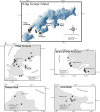Diversity and extracellular enzymatic activities of yeasts isolated from King George Island, the sub-Antarctic region
- PMID: 23131126
- PMCID: PMC3499239
- DOI: 10.1186/1471-2180-12-251
Diversity and extracellular enzymatic activities of yeasts isolated from King George Island, the sub-Antarctic region
Abstract
Background: Antarctica has been successfully colonized by microorganisms despite presenting adverse conditions for life such as low temperatures, high solar radiation, low nutrient availability and dryness. Although these "cold-loving" microorganisms are recognized as primarily responsible for nutrient and organic matter recycling/mineralization, the yeasts, in particular, remain poorly characterized and understood. The aim of this work was to study the yeast microbiota in soil and water samples collected on King George Island.
Results: A high number of yeast isolates was obtained from 34 soil and 14 water samples. Molecular analyses based on rDNA sequences revealed 22 yeast species belonging to 12 genera, with Mrakia and Cryptococcus genera containing the highest species diversity. The species Sporidiobolus salmonicolor was by far the most ubiquitous, being identified in 24 isolates from 13 different samples. Most of the yeasts were psychrotolerant and ranged widely in their ability to assimilate carbon sources (consuming from 1 to 27 of the 29 carbon sources tested). All species displayed at least 1 of the 8 extracellular enzyme activities tested. Lipase, amylase and esterase activity dominated, while chitinase and xylanase were less common. Two yeasts identified as Leuconeurospora sp. and Dioszegia fristingensis displayed 6 enzyme activities.
Conclusions: A high diversity of yeasts was isolated in this work including undescribed species and species not previously isolated from the Antarctic region, including Wickerhamomyces anomalus, which has not been isolated from cold regions in general. The diversity of extracellular enzyme activities, and hence the variety of compounds that the yeasts may degrade or transform, suggests an important nutrient recycling role of microorganisms in this region. These yeasts are of potential use in industrial applications requiring high enzyme activities at low temperatures.
Figures
References
-
- Robinson CH. Cold adaptation in Arctic and Antarctic fungi. New Phytol. 2001;151:341–353. doi: 10.1046/j.1469-8137.2001.00177.x. - DOI
Publication types
MeSH terms
Substances
Associated data
- Actions
- Actions
- Actions
- Actions
- Actions
- Actions
- Actions
- Actions
- Actions
- Actions
- Actions
- Actions
- Actions
- Actions
- Actions
- Actions
- Actions
- Actions
- Actions
- Actions
- Actions
- Actions
- Actions
- Actions
LinkOut - more resources
Full Text Sources
Other Literature Sources
Molecular Biology Databases


